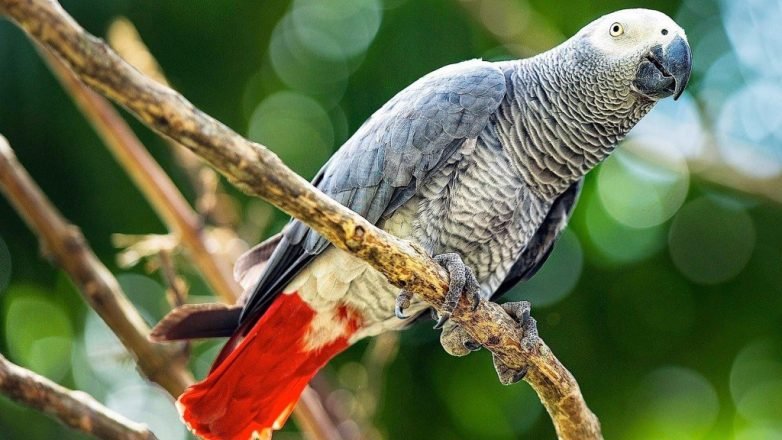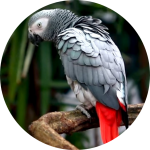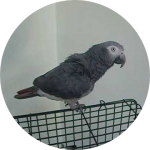African Grey Parrot

African Grey Parrot Guide
African Grey Parrot Personality Food & Care:
One of the foremost intelligent birds ever studied, the African gray parrot has a tremendous ability to imitate speech. they will be howling and tender, but, like different giant parrots, African greys square measure thought-about high maintenance pets. whereas “greys” square measure entertaining and satisfying to stay, they like a routine schedule and need a considerable quantity of your time with their house owners. Therefore, African gray parrots might not be acceptable for those that work odd hours, travel ofttimes, or pay several hours off from home.
Biological Facts Grey Parrot:
African gray Parrot (Psittacus erithacus); 2 taxonomic category
Congo African Grey: larger body, light-grey coloration, all-black beak, and bright red tail feathers
Timneh African Grey: smaller body, darker-grey coloration, flesh-colored prime half beak, and dark maroon tail feathers
Weight: 330-500 gram
Young birds have dark gray irises that flip yellowness at one year ancient
Sexual maturity: 4-6 years
Avg. life span: 25-30 years
Maximum recorded life span: 50+ years
Origins: West and Central Africa
Behavior Grey Parrot:
Frequently bonds with one loved one, rejecting others. Often fearful or impatient strangers. Parent-raised Psittacus erithacus chicks square measure thought-about to be higher adjusted than those raised entirely by humans. Baby birds that receive human handling whereas still within the nest tend to indicate fewer activity issues (e.g. feather choosing, fearfulness, aggression) at maturity than people who don’t. Tamed birds pronto adapt to new surroundings and activities; expose early to daily activities in your family similarly on different pets Are intelligent, curious, and like to explore their surroundings. Need environmental enrichment, attention-grabbing toys, and hunt exercises to scale back the possibility of activity issues.
Diet & Food of Grey Parrot:
Wild African gray parrots take advantage of a range of fruits, nuts, and vegetables. Seed-based diets aren’t suggested as they enable pet birds to pick Associate in Nursing unbalanced diet from what’s offered. Formulated diets (“pellets” or “crumbles”) give additional complete and balanced nutrition, don’t permit selective feeding, and may comprise concerning seventy fifth of the diet Dark foliose greens, vegetables, and fruits will form up 20-25% of diet Treats ought to be restricted to solely five-hitter of the diet Clean, Water ought to be provided daily Environment.
Enclosures ought to be as giant as potential, specified the bird is in a position to totally extend it’s wings and flap while not touching the cage walls Cage ought to be clean, secure, safe and made of sturdy, non-toxic materials Perches ought to be of variable widths, heights, and textures. conjointly give a concrete perch to assist to take care of the toenails. Avoid putting perches directly over food or water to stop contamination Access to natural light-weight is most well-liked, and supplemental { uv | ultraviolet | ultraviolet radiation | ultraviolet light-weight | ultraviolet illumination | UV | actinic radiation | actinic ray } light is also suggested to treat or forestall feather choosing or hypocalcaemia. Avoid draughty areas. Parrots ought to keep in their cage or a “bird safe” space once they aren’t beneath direct oversight.
Birds with unrestricted access to the house square measure in danger for accidents like poison intake, electrocution, pet attacks, and drowning.
Preventive Care of Grey Parrot:
Physical examinations each 6-12 months. Consult a veterinary with expertise in vertebrate drugs if you’ve got any queries or considerations concerning your bird’s health.
Annual faecal examination for parasites, yeast, and microorganism Vaccination for Polyomavirus, as directed by your veterinary Routine blood testing. Wing, manicure as required Common Medical Disorders Behavioral issues (e.g. feather choosing, fearfulness, aggression)
Respiratory diseases:
Hypoglycemia syndrome Circuitous (PBFD virus)
Nasal blockages (bacterial, fungal, secondary to malnutrition)
Proventricular Dilatation Disease (PDD)
Breeding of African Grey:
Grey Parrots don’t seem to be troublesome to breed provided three conditions are met:
they feel secure and may relish privacy, they receive an honest diet and that they ar offered the correct nesting box. Meeting one and not the opposite conditions will thwart breeding. My recommendation was to supply them nesting boxes that were thirty cm (12 in) sq. and sixty cm (24 in) deep, or if he most well-liked horizontal nests sixty cm long and thirty cm sq. presently exploitation L-shaped nests that measure close to forty five cm (18 in) high on the tall finish and twenty cm (8 in) on the short finish, forty five cm (18 in) long and thirty five cm (14 in) deep. The nests have unsound wood value-added to permit mastication. I realize that this activity and also the got to pay time within a dark nest stimulates endocrine development. the best African gray Parrot enclosure ought to be non-public and quiet. they ought to be unbroken faraway from buzzing conures, cockatoos, Amazons and macaws. They dislike terribly bright daylight once nesting; within the wild they nest in forest however once not breeding relish perching exposed to the atmosphere or fly over forest. In captivity, African gray Parrots tend to supply multiple clutches. Some seem to nest year around, however they are doing rest. In my assortment, as an example, they stop nesting once the weather becomes hottest. Once they stop, access to the nest is blocked. This obstruction of the nest emulates nature, wherever they leave nesting grounds once the young fledge.
TYPES OF AFRICAN GREY PARROT


